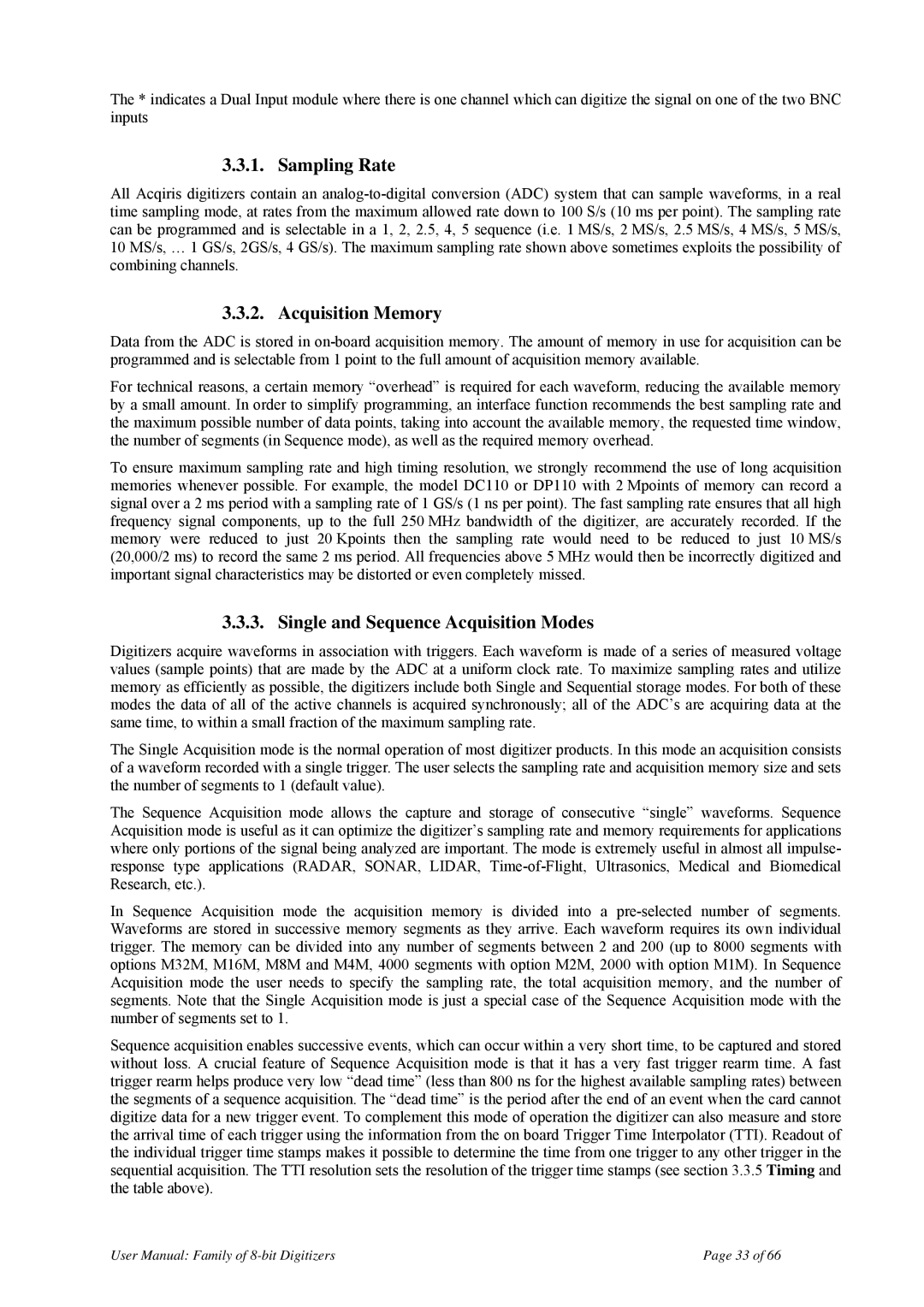The * indicates a Dual Input module where there is one channel which can digitize the signal on one of the two BNC inputs
3.3.1. Sampling Rate
All Acqiris digitizers contain an
3.3.2. Acquisition Memory
Data from the ADC is stored in
For technical reasons, a certain memory “overhead” is required for each waveform, reducing the available memory by a small amount. In order to simplify programming, an interface function recommends the best sampling rate and the maximum possible number of data points, taking into account the available memory, the requested time window, the number of segments (in Sequence mode), as well as the required memory overhead.
To ensure maximum sampling rate and high timing resolution, we strongly recommend the use of long acquisition memories whenever possible. For example, the model DC110 or DP110 with 2 Mpoints of memory can record a signal over a 2 ms period with a sampling rate of 1 GS/s (1 ns per point). The fast sampling rate ensures that all high frequency signal components, up to the full 250 MHz bandwidth of the digitizer, are accurately recorded. If the memory were reduced to just 20 Kpoints then the sampling rate would need to be reduced to just 10 MS/s (20,000/2 ms) to record the same 2 ms period. All frequencies above 5 MHz would then be incorrectly digitized and important signal characteristics may be distorted or even completely missed.
3.3.3. Single and Sequence Acquisition Modes
Digitizers acquire waveforms in association with triggers. Each waveform is made of a series of measured voltage values (sample points) that are made by the ADC at a uniform clock rate. To maximize sampling rates and utilize memory as efficiently as possible, the digitizers include both Single and Sequential storage modes. For both of these modes the data of all of the active channels is acquired synchronously; all of the ADC’s are acquiring data at the same time, to within a small fraction of the maximum sampling rate.
The Single Acquisition mode is the normal operation of most digitizer products. In this mode an acquisition consists of a waveform recorded with a single trigger. The user selects the sampling rate and acquisition memory size and sets the number of segments to 1 (default value).
The Sequence Acquisition mode allows the capture and storage of consecutive “single” waveforms. Sequence Acquisition mode is useful as it can optimize the digitizer’s sampling rate and memory requirements for applications where only portions of the signal being analyzed are important. The mode is extremely useful in almost all impulse- response type applications (RADAR, SONAR, LIDAR,
In Sequence Acquisition mode the acquisition memory is divided into a
Sequence acquisition enables successive events, which can occur within a very short time, to be captured and stored without loss. A crucial feature of Sequence Acquisition mode is that it has a very fast trigger rearm time. A fast trigger rearm helps produce very low “dead time” (less than 800 ns for the highest available sampling rates) between the segments of a sequence acquisition. The “dead time” is the period after the end of an event when the card cannot digitize data for a new trigger event. To complement this mode of operation the digitizer can also measure and store the arrival time of each trigger using the information from the on board Trigger Time Interpolator (TTI). Readout of the individual trigger time stamps makes it possible to determine the time from one trigger to any other trigger in the sequential acquisition. The TTI resolution sets the resolution of the trigger time stamps (see section 3.3.5 Timing and the table above).
User Manual: Family of | Page 33 of 66 |
